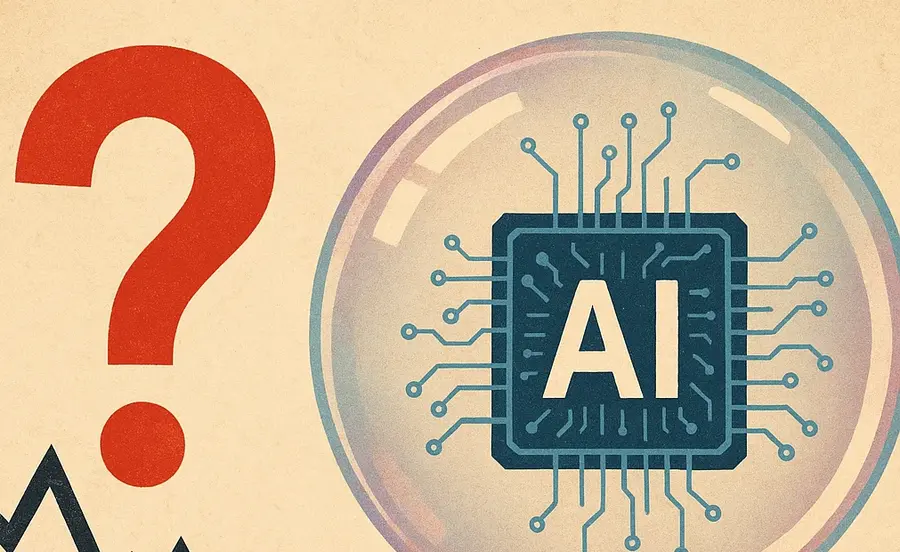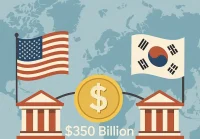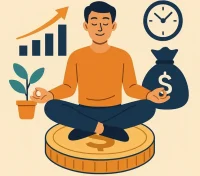Is there going to be an AI bubble burst? The answer from Silicon Valley entrepreneur and futurist Jerry Kaplan is definitive: “F yes.” There’s no question that we’re in a significant bubble, and this one may be bigger and more dangerous than the dot-com crash that devastated markets in 2000. With 80% of US stock market gains tied to AI companies and circular financing creating artificial valuations, the warning signs are everywhere.
The Scale of the Problem: Bigger Than Dot-Com
This AI bubble is quite a bit bigger than the last major bubble, which was very destructive. About 80% of the gains in the US stock market have been attributable to a very small handful of companies, all of which are big in AI. This concentration creates considerable risk both in the stock market and the collateral damage that would occur in the wider economy.
The valuations we’re talking about are massive. Nvidia, the chip maker, is now bigger than the UK economy by a stretch—almost 20% bigger than the whole of the UK economy. If you’ve got a pension, if you’ve got savings anywhere in the world, you will not be left standing if there is a reckoning in this market.
The Circular Financing Problem: Companies Investing in Each Other
One of the most concerning aspects of the AI bubble is the circular financing that’s been happening. The case that’s drawn most attention was a deal in late September between Nvidia and OpenAI whereby Nvidia agreed to invest up to $100 billion in OpenAI to fund more data centers, and OpenAI pledged to purchase millions of NVIDIA chips for those same data centers.
This looks suspiciously circular, as if Nvidia and OpenAI are just passing money between themselves to inflate their revenues. This is far from the only case—Nvidia has similarly incestuous relationships with most big AI companies. If there was real demand for their product, why would they have to put their money at work propping up their customers?
The AI Gold Rush Needs Real Builders — Not Financial Loops
Behind the billion-dollar headlines, the real opportunity lies with the innovators building sustainable AI infrastructure. Hire data engineers, ML specialists, and infrastructure architects who can create genuine value — not circular hype. Build teams that outlast the bubble.
Build Your AI Team Now →The Investment-Revenue Mismatch: Building for Demand That Doesn’t Exist
There is not going to be a need for anywhere near the kind of capacity that’s being built out in these data centers for a very long time. Nobody ever made money betting that computing was going to be more expensive in the future. You’re investing in these Nvidia chips that are very high priced right now, and when you look at what they’re going to be worth in three years, the lifetime of those chips is maybe three years.
You go buy $10 billion of those and you stuff them into some kind of giant warehouse out in the middle of some remote desert. What do you think that’s going to be worth in three years? The answer is obviously not. We’re going to wind up with a new kind of ecological hazard—enormous acres and acres of data centers out in the middle of nowhere with the lights out, rusting away and full of all kinds of toxic materials.
The Economic Dependence: 40% of US Growth Tied to AI
The AI bubble has become a systemic risk to the entire US economy. Forty percent of US economic growth at the moment is entirely AI. If you take out AI from the US economy and look at business investment, then it’s actually a downward trend, which means all of the other economic policies, including tariffs, are somehow being shielded by this huge capital investment.
This massive investment is covering up the fact that money is being pulled from clean energy projects, electric vehicles, and health research. We’re giving up on health research that’s fundamental to improving the health welfare of Americans. This is about exploiting what we’ve got right now to get as much as you can for a very small group of very wealthy people.
The Technology Reality: AI’s Fundamental Limitations
Artificial intelligence is a fabulous innovation and it’s going to be a tremendous advantage in automation, but it is not what you see on TV or in the movies. It’s got very specific limitations which are quite real and fundamental to the current wave of technology. These systems are very good at certain kinds of prediction, short-term prediction of new words and pictures, but there’s a myth that they can reason and think.
The truth is that these systems cannot reason and cannot think at all. They are not logically based. They give you the most plausible answer, not the most accurate answer. That’s a very important distinction. Most of the people working in this field, even right here in Silicon Valley, do not understand the fundamental limitations of this new wave of technology.
The Employment Impact: Who Loses Jobs First?
Every advance in automation has had exactly the same effects. Short-term it puts some people out of work, it makes us wealthier, and that wealth creates new kinds of jobs. What it really does in the end is it changes the nature of work—how we do our jobs and what jobs we get paid to do.
Computer programmers are more likely to lose their jobs first because the nature of programming is in the process of changing. For the first time at Stanford University, graduates who were so sure they were going to get out and get that big ticket job are not getting job offers. But people who are involved in face-to-face interactions, in professions where the authentic expression of human emotions such as empathy or concern are very important, they’re not going to have a problem because you really can’t get that out of a computer.
The Bubble Psychology: Fear of Missing Out
The amount of money going into some of these deals to build out this infrastructure for chips that may or may not be obsolete is reflective of how people get in bubbles. It’s “Oh my god, there’s so much money being made and I’m looking at the share price and I don’t want to miss out.” Everyone keeps talking about the risks and the possibilities, but they keep piling in and buying, buying, buying.
This fear of missing out by investors is driving the frenzy, with all these companies—OpenAI and Oracle and Microsoft and Nvidia and AMD—making deals that make people feel even more nervous that it’s the same players at the top that are feeding this frenzy.
Don’t Hire Out of FOMO — Hire for Foundations
In AI’s gold-rush moment, the smartest companies aren’t chasing hype — they’re hiring talent that builds lasting value. Data engineers, machine-learning ops, and infrastructure experts who understand scalability, not speculation. Build intelligently while others buy impulsively.
Find Proven AI Talent →When Will the Bubble Burst?
The honest answer is when the retail investors—when there’s nobody at the end of the line who’s willing to pick up the investment at a markup from the people who hold it now, that’s when the whole thing will collapse. Unfortunately, that’s usually when it comes down to the retail investors.
What to really look out for is when there’s all of a sudden a way for mom and pop in Topeka, Kansas to be able to invest in AI, some kind of AI fund or whatever it is. That’s when we’re going to really see the end of this bubble, and that’s not going to be a pretty process.
Can the Bubble Be Deflated Gradually?
There’s no bubble in history, economic bubble, that has slowly deflated. The truth is that you could still make a lot of money on AI trades today, even though everyone is discussing this bubble imminently bursting. There could still be considerable time to go before you see this burst, with an average of about 6 to 9 months before bubbles burst even when you call it.
The momentum continues because people can still make money, and there’s considerable time to go before the bubble actually bursts. Everyone keeps talking about the risks and possibilities, but as we’ve seen in recent weeks and months, they keep piling in and buying.
The Bottom Line: Inevitable Collapse
The AI bubble is bigger than the dot-com crash and represents a systemic risk to the global economy. With 40% of US economic growth tied to AI investment that may never pay off, circular financing inflating valuations, and fundamental limitations in the technology itself, the collapse is inevitable.
The question isn’t whether the bubble will burst, but when. And when it does, it will be the retail investors—the mom and pops with their 401ks and pension funds—who get stuck holding the bag while the investment banks and venture capitalists walk away with their profits.
FAQ Section
Q: Is the AI bubble bigger than the dot-com crash?
A: Yes, the AI bubble is bigger than the dot-com crash, with 80% of stock market gains tied to AI companies and valuations that dwarf previous bubbles.
Q: Why is circular financing a problem?
A: Circular financing, where companies invest in each other (like Nvidia investing $100 billion in OpenAI), inflates valuations artificially and creates a house of cards that will collapse when real demand doesn’t materialize.
Q: What happens when the AI bubble bursts?
A: When the AI bubble bursts, retail investors with 401ks and pension funds will be left holding the bag, while the investment banks and venture capitalists who created the bubble walk away with their profits.
Q: Can the bubble be deflated gradually?
A: No, there’s no bubble in history that has slowly deflated. Bubbles always burst suddenly, and this one will be no different.
The Path Forward: Prepare for the Inevitable
The AI bubble represents one of the greatest economic risks in modern history. With 40% of US economic growth dependent on AI investment that may never pay off, and circular financing creating artificial valuations, the collapse is not just likely—it’s inevitable. The only question is when, and the answer is when retail investors can no longer be convinced to buy into the hype.
The sooner the bubble is popped, the sooner people wake up and understand that this is overinvestment in an area that doesn’t justify the massive capital allocation. The longer it continues, the more damage it will do to the economy and the more people will be hurt when it finally collapses.




